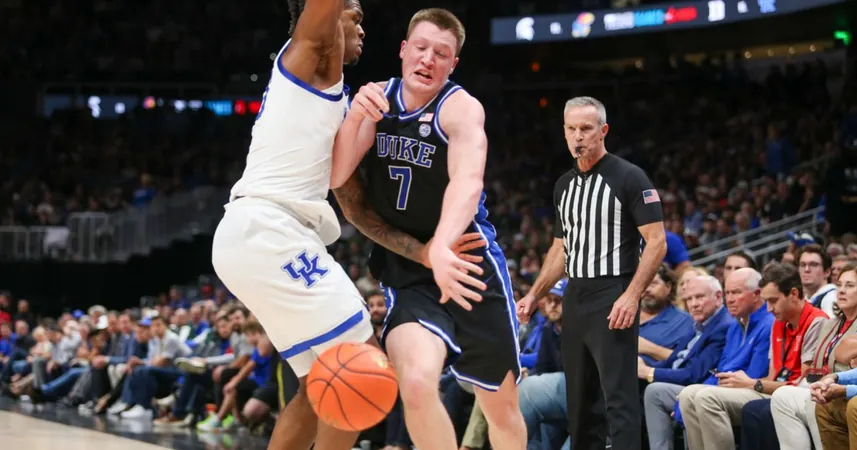
Kentucky Basketball Transforms Ball-Screen Defense Under Mark Pope's Leadership
2024-11-14
Author: Ken Lee
In a stunning display of defensive prowess, the Kentucky Wildcats, under the guidance of head coach Mark Pope, showcased a remarkable transformation in their approach to ball-screen defense during their recent matchup against Duke in the Champions Classic. Big Blue Nation witnessed a pivotal shift that might just redefine the season ahead.
In the first half, it felt as though Duke could score at will. Dominating in the paint, they netted 28 of their 40 total points, flaunting a nearly 50% shooting percentage. Much of this success stemmed from their effective use of ball screens, where Cooper Flagg consistently exploited mismatches, driving at will against Koby Brea after simple switches.
However, this isn’t solely a critique of Brea. Kentucky's decision to switch everything on defense highlighted a recurring issue for the team, echoing frustrations that have lingered among fans. The simplistic strategy, effective in lower-stakes games, left the Wildcats vulnerable against a high-caliber opponent like Duke.
A New Defensive Philosophy Emerges
Mark Pope has set out to alter the course that John Calipari had navigated for years, particularly regarding ball-screen defense. While Calipari often relied on a blanket switching strategy, Pope emphasizes versatility and communication among players, allowing for more dynamic responses to opponents’ plays. This change aims to prepare the Wildcats not just for collegiate competition but also to develop skills necessary for professional basketball.
Reflecting post-game, Pope acknowledged the learning curve for his players, stating, “I probably should’ve gotten a little more aggressive in the first half… We were pulverized in transition, isolation, and in ball screens. We knew we had to take a bunch of shots at being more aggressive.” Such candor revealed Pope’s commitment to gauging his team’s strengths and weaknesses before implementing adjustments.
Proactive Adjustments Yield Results
Diving deeper into details, Pope elaborated on the shortcomings of their first-half execution. “Our ball screen defense was bad. It was a little over 1.5 points per possession on ball-screen defense,” he explained, highlighting the need to challenge opponents effectively. The adjustments came in the second half, where Kentucky switched up its defensive tactics, confusing Duke by utilizing blitzes and diverse layering in their ball-screen strategy.
This tactical flexibility marked a significant departure from the consistency that plagued Kentucky in the first half. By keeping Duke on high alert, Coach Pope ensured that even a team that may lack elite individual defenders could succeed through strategic innovation.
In the end, while Kentucky may not yet boast a roster filled with defensive juggernauts, Coach Mark Pope’s leadership and tactical adjustments instill hope that this team can evolve into a formidable contender. As the season progresses, fans will be eager to see how this new defensive philosophy manifests in future games, eagerly anticipating potential upsets and standout performances along the way.

 Brasil (PT)
Brasil (PT)
 Canada (EN)
Canada (EN)
 Chile (ES)
Chile (ES)
 España (ES)
España (ES)
 France (FR)
France (FR)
 Hong Kong (EN)
Hong Kong (EN)
 Italia (IT)
Italia (IT)
 日本 (JA)
日本 (JA)
 Magyarország (HU)
Magyarország (HU)
 Norge (NO)
Norge (NO)
 Polska (PL)
Polska (PL)
 Schweiz (DE)
Schweiz (DE)
 Singapore (EN)
Singapore (EN)
 Sverige (SV)
Sverige (SV)
 Suomi (FI)
Suomi (FI)
 Türkiye (TR)
Türkiye (TR)